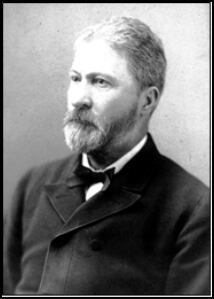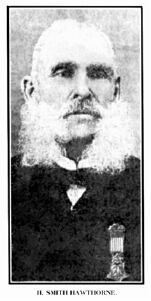Gen. Robert E. Lee's son, Maj. Gen. G.W. Custis Lee, purportedly refused to surrender to a private in the Union Army. But that doesn't mean a private didn't capture the Confederate during a vicious battle at Sailor's Creek on April 6, 1865.
More than 151 years later, the descendants of this young private are fighting to honor their hero and convince the federal government the wrong man was awarded the Medal of Honor for capturing the elusive target and famous general's son.
Pvt. David Dunnels White, of the Massachusetts 37th Regiment, watched his lieutenant get shot as he tried to force Custis Lee to surrender. White then pursued Lee behind enemy lines and successfully captured him, according to an assemblage of research by his great- great- great-grandson Frank White.
This descendant now has members of Congress sponsoring legislation to approve the Civil War vet's Medal of Honor. And Frank White also has a June 10 appointment with Pentagon brass to state his case.
Frank White, of Lebanon, New Jersey, wrote a book about the event called "Sailor's Creek: Maj. Gen. G.W. Custis Lee, Captured With Controversy " in 2008 after decades of research. He said feedback from historians convinced him to pursue a case with the Army.
Initially, a Medal of Honor was presented to Cpl. Harris S. Hawthorne for capturing Lee. But White said evidence suggests Hawthorne merely re-captured Lee in chaos afterwards.
"I wrote the book documenting the evidence as objectively as I could, even though I had a relative involved," said Frank White. "The physical evidence is overwhelmingly on (David) White's side."
While he was rejected by the Pentagon once, he's made a good enough case for a second chance. Meanwhile his Ccongressman, Leonard Lance, R-N.J., introduced legislation Thursday, to get David White recognized with the nation's highest valor award.
"The White Family asked for my assistance, and I was happy to meet with them regarding their strong case," Lance said in a press release. "The capture of Custis Lee was a turning point in the Civil War and proved a psychological blow to Robert E. Lee. I have reviewed the materials presented by the White Family and I am convinced that it has merit."
Blood at Sailor's Creek
Three days before Lee surrendered to Gen. Ulysses S. Grant at Appomattox Courthouse, the Battle at Sailor's Creek, constituted the last major engagement of America's bloodiest war.
With Grant having broken Confederate defenses of Petersburg days earlier, the Confederates were on their heels. The Confederates evacuated Petersburg and Richmond overnight on April 2-3, and began retreating in hopes of eventually linking up with larger numbers in North Carolina.

George Washington Custis Lee
Photo Credit: Courtesy Frank White
The Union Army pursued and engaged in a series of battles known as the Appomattox Campaign. On April 6, about 25,000-36,000 Union forces met between 17,000-18,000 Confederate outside of Farmville, Virginia. What followed was one of the most brutal battles of the war, with shooting devolving into bayonet and hand-to-hand combat. There were even reports of soldiers biting one another.
White saw his lieutenant confront a Confederate officer at gunpoint; he didn't know at the time that the man was none other than Robert E. Lee's son. The Confederate shot the Union officer in the chest (he would miraculously survive despite the bullet ricocheting through his body down toward his groin) and retreated.
"There was a long battle line, with soldiers bayoneting and shooting each other," Frank White said. "Lee falls back from that line; White pursues him, halts him and gets the drop on him before he can pull out his revolver. He told him 'I'm going to shoot you dead' unless he surrendered."
Lee apparently told White that he wasn't going to hand over his sword to a private, and demanded White summon an officer. White obliged, and Lee's revolver, sword, and personal effects were confiscated, according to Frank White's historical accounts.
The Ccontroversy
So how did Hawthorne get all the credit? Frank White suspects Lee almost escaped at some point during the transfer of prisoners — keep in mind that there were 7,700 Confederates captured in this battle alone. Hawthorne likely caught Custis Lee during an attempted getaway, Frank White suspects.
The Civil War and following decades were a messy time when it came to documenting awards like the Medal of Honor, an honor itself created during the war. Because the military had never had to deal with a valor awards process for such a vast war, many awards came long after-the-fact. Cpl. Hawthorne received his Medal of Honor for capturing Custis in 1894; ultimately it was one of 56 awarded for actions at Sailor's Creek. Based on White's research, the honor quickly created controversy, as White's regiment read about it in a newspaper and filed a protest in 1897.
During that investigation, Hawthorne said in an affidavit that when he demanded Lee's weapons, Lee responded: "I don't have as much as a jackknife." (Frank White now reasons that's evidence he'd been captured before Hawthorne encountered him.)
After the 1897 investigation, then-Secretary of War Russell Alger asked for the medal back. But Alger lacked the authority to rescind it, and Hawthorne refused to return it.

Harris Hawthorne
Photo Credit: Courtesy Frank White
"He didn't know what to do," Frank White said of Alger.
Ultimately it was ruled that year that the act of capturing Lee was not worthy of a Medal of Honor.
In 1916, the government launched a Medal of Honor Review Board to look at awards given during the Civil War to add legitimacy to the honor. About a third of Medals of Honor from the war were rescinded, White said, for a variety of reasons (including the fact some were given to civilians.) But that review also determined that the capture of Lee was worthy of the award, allowing Hawthorne's to stand. This review did not examine whether someone else should have been recognized for that achievement instead.
Frank White discovered the story of his ancestor and Lee in the regiment's history while doing family research, and learned later of a Medal of Honor awarded to someone else for the same feat. That's what prompted him to take a deep dive into the documentation.
After writing his book and being told he was onto something, he put together a draft package for the Army to consider. White said Human Resources Command offered him some coaching, such as what kind of information and standard of evidence the Senior Army Decorations Board would want. But after submitting the packet, he got a letter back on March 8 of this year from Acting Secretary of the Army Patrick Murphy that said he and the SADB denied the award.
Yet the logic, he said, didn't make sense: Murphy's grounds were that he had been denied in 1897 and again in 1916. So White pushed back, pointing out that the 1916 review restored the act to worthy of a Medal of Honor, and at the same time did not even consider whether to award White for the act as it had Hawthorne.
Aside from Congress and eventually Presidential sign-off on the award, he still needs the Army's approval—and he'll get his chance to make a case in person. On June 10 he will meet with G-1 (Personnel) leadership at the Pentagon, with leaders from Human Resources Command at Fort Knox, Kentucky, flying in as well. The meeting was organized by Lt. Gen James McConville, the G-1 boss, White said.




